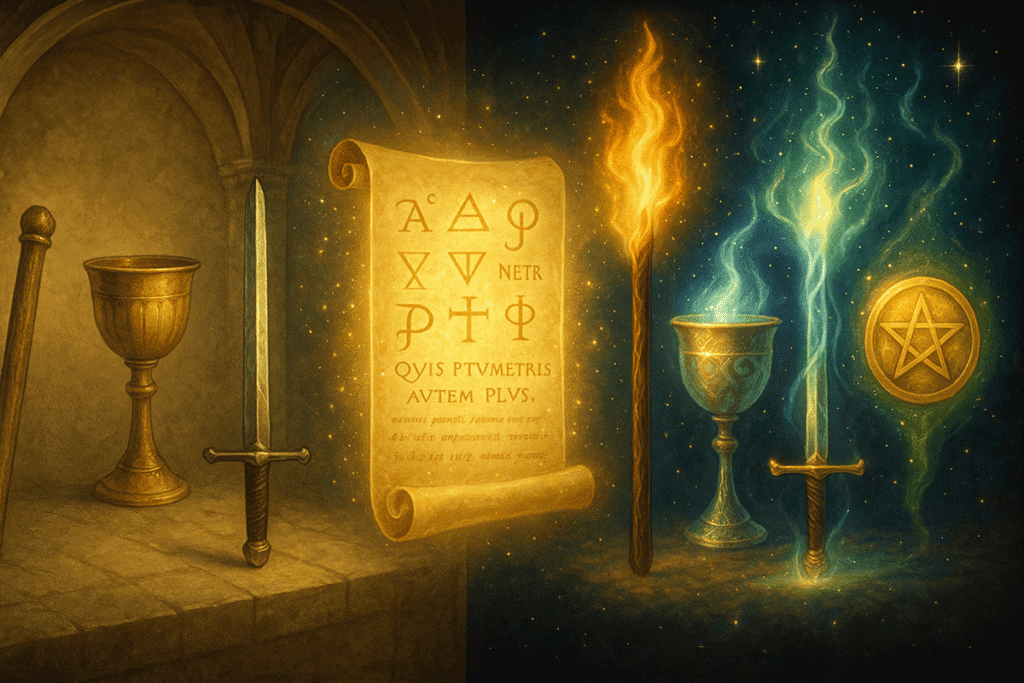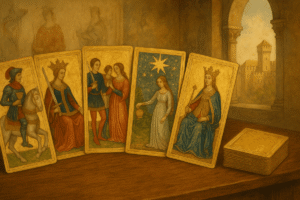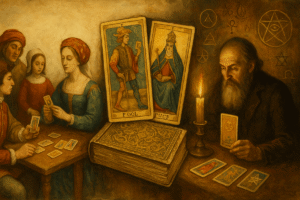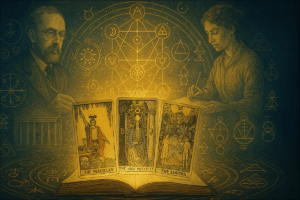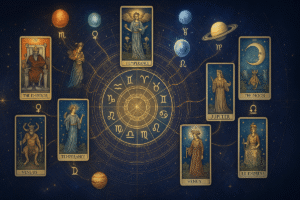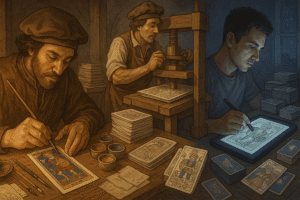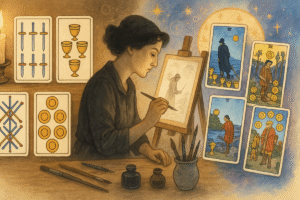Table of Contents
The four suits of the tarot’s Minor Arcana have undergone a fascinating transformation throughout history. What began as practical Italian symbols has evolved into the mystical imagery we recognize today. This evolution reflects not just changing artistic preferences, but a deeper shift in how people approach these ancient cards for personal reflection and growth.
The Original Italian Foundation
When tarot cards first appeared in 15th century Italy, they bore symbols that would have been immediately familiar to anyone walking through a medieval marketplace. The original suits were Bastoni (Batons), Coppe (Cups), Spade (Swords), and Denari (Coins). These weren’t mystical symbols at all, really. They represented the tools and concerns of everyday life.
I find it interesting how practical these original choices were. Batons represented work and craftsmanship, the physical tools needed to build and create. Cups spoke to celebration, sustenance, and the social bonds formed over shared meals. Swords embodied conflict and authority, the instruments of both protection and power. Coins, perhaps most obviously, symbolized trade, wealth, and material success.
These early Italian decks served multiple purposes. They were used for card games, certainly, but also as a way to explore the human condition through familiar imagery. The symbols chosen weren’t arbitrary; they reflected the four pillars of medieval society: labor, community, authority, and commerce.
The Occult Revival and Symbol Transformation
The 19th century brought a renewed interest in esoteric traditions across Europe. Occultists and mystics began to see tarot not just as a card game, but as a tool for deeper contemplation and self-discovery. This shift in perspective naturally led to changes in the symbolic language of the suits.
The transformation wasn’t sudden or uniform. Different occult traditions made their own modifications, sometimes keeping traditional names while adding new layers of meaning. The Golden Dawn, perhaps the most influential of these groups, played a crucial role in standardizing what would become the modern suit names we know today.
Batons became Wands, a change that might seem subtle but carries significant weight. Where batons suggested crude tools or weapons, wands implied magical implements, instruments of will and intention. This shift reflects a move from physical labor to spiritual work, from external action to internal transformation.
The evolution of Denari to Pentacles represents perhaps the most dramatic symbolic change. Coins were straightforward representations of material wealth and trade. Pentacles, however, introduced the five-pointed star, a symbol rich with esoteric meaning. The pentagram had long been associated with the elements, protection, and the human form in occult traditions.
Philosophical Shifts in Symbolic Meaning
These name changes weren’t merely cosmetic. They reflected a fundamental shift in how practitioners approached the cards for personal insight. The original Italian suits focused on external circumstances and social roles. The occult reinterpretation emphasized internal processes and spiritual development.
Consider how this change affects interpretation. When someone draws a card from the suit of Coins, they might reflect on material concerns, financial situations, or practical matters. But a card from the suit of Pentacles invites consideration of how material circumstances relate to spiritual growth, how earthly experiences serve higher purposes.
This philosophical evolution continues to influence how people use tarot for self-reflection today. The symbolism encourages users to look beyond surface meanings and consider deeper patterns in their lives. It’s a shift from asking “What will happen to me?” to “How can I grow from this experience?”
Regional Variations and Cultural Adaptations
Not every tarot tradition embraced the same symbolic evolution. French tarot maintained closer ties to the original Italian naming, often using Bâtons, Coupes, Épées, and Deniers. Spanish and Portuguese traditions developed their own variations, sometimes blending medieval imagery with local cultural elements.
These regional differences remind us that tarot’s symbolic language isn’t fixed or universal. Different cultures have emphasized different aspects of the human experience through their choice of suit symbols. What resonates in one tradition might feel foreign in another.
I think this diversity actually strengthens the tarot tradition rather than weakening it. It suggests that the core insight of the four-suit system transcends specific symbols. Whether you’re working with Batons or Wands, the underlying invitation to explore different aspects of human experience remains consistent.
The Modern Synthesis
Today’s tarot practitioners often work with decks that blend traditional and modern symbolism. Many contemporary decks acknowledge both the historical Italian roots and the occult transformations, sometimes including both names or creating entirely new interpretations of the suit symbols.
This synthesis approach reflects a mature understanding of tarot’s evolution. Rather than insisting on one “correct” version, modern practitioners recognize that different symbolic languages serve different purposes. Someone drawn to historical accuracy might prefer traditional Italian terminology. Another person seeking spiritual insights might gravitate toward occult naming conventions.
The flexibility in suit naming also reflects changing cultural attitudes toward authority and tradition. Where earlier generations might have insisted on orthodox interpretations, contemporary tarot culture celebrates innovation and personal meaning-making. This shift parallels broader cultural trends toward individualization and self-directed spirituality.
What These Changes Reveal About Human Nature
Perhaps the most fascinating aspect of the tarot suits’ evolution is what it reveals about changing human concerns and aspirations. The movement from Batons to Wands suggests a shift from collective labor to individual empowerment. The transformation of Coins to Pentacles reflects growing interest in connecting material life with spiritual purpose.
These changes don’t represent progress in any linear sense. The original Italian symbols weren’t primitive versions of modern ones. Instead, they reflected the concerns and worldview of their time. The occult transformations addressed different needs, speaking to people seeking personal transformation rather than social integration.
When I reflect on this evolution, I’m struck by how it mirrors broader changes in Western culture. The medieval world emphasized community, hierarchy, and acceptance of one’s place in society. The modern world values individual growth, personal agency, and self-directed meaning-making. Tarot’s symbolic evolution both reflects and has perhaps contributed to this cultural shift.
Using Historical Awareness in Personal Practice
Understanding the historical evolution of tarot suit symbols can enrich personal reflection practice. When drawing cards, consider both the traditional and modern meanings of the suits. A Wands card might invite you to think about both practical work (the Baton meaning) and spiritual intention (the Wand meaning).
This historical awareness doesn’t require choosing one interpretation over another. Instead, it offers multiple lenses through which to examine the same situation. Sometimes the practical, earthly interpretation of Coins might be most relevant. Other times, the spiritual transformation suggested by Pentacles could provide deeper insight.
The key is remaining open to different layers of meaning. The evolution of tarot symbolism teaches us that meaning isn’t fixed or final. Our understanding of ourselves and our circumstances can deepen through exposure to different symbolic languages and interpretive frameworks.
Perhaps most importantly, recognizing how tarot symbols have changed over time reminds us that we’re part of an ongoing conversation. The cards we use today represent centuries of human reflection on fundamental questions about purpose, relationship, challenge, and growth. That’s both humbling and empowering to consider.
Frequently Asked Questions
Why did Coins become Pentacles in modern tarot decks?
The change from Coins to Pentacles occurred as divination practices expanded, allowing the suit to represent broader material concerns beyond just money matters, including home, health, and career. Arthur Waite popularized the term “Pentacles” around 1910 in the Rider-Waite deck, deliberately leaving the French word “pantacles” untranslated from Éliphas Lévi’s work, which English speakers interpreted as “pentacles.”
Are Batons and Wands the same suit with different names?
Yes, Batons and Wands refer to the same suit but reflect different cultural and temporal contexts. The original Italian tarot decks from the 1440s used Batons (Bastoni), while later occult traditions adopted the name Wands to emphasize magical and spiritual associations rather than physical labor. The name you encounter often depends on whether a deck follows traditional Italian designs or modern esoteric conventions.
Do different suit names change the meaning of the cards?
Different names like Coins, Disks, and Pentacles are used for the same suit with the same basic associations. The underlying themes remain consistent across naming variations, though the specific name can offer subtle hints about the deck’s cultural or spiritual perspective. What matters most for personal reflection is understanding the core symbolism each suit represents rather than getting attached to particular terminology.
Which tarot tradition should I follow for suit names?
There’s no single “correct” tradition to follow. Traditional Italian decks use Coins, the Rider-Waite tradition uses Pentacles, and the Thoth tradition uses Disks. The choice often comes down to which deck resonates with your personal practice and which symbolic language helps you engage most meaningfully with the cards for self-reflection.

